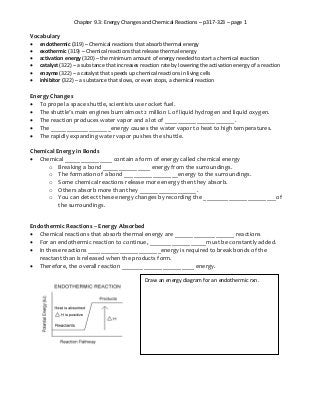
Chapter 9.3: Energy Changes and Chemical Reactions
- 1. Chapter 9.3: Energy Changes and Chemical Reactions – p317-323 – page 1 Vocabulary endothermic (319) – Chemical reactions that absorb thermal energy exothermic (319) – Chemical reactions that release thermal energy activation energy (320) – the minimum amount of energy needed to start a chemical reaction catalyst (322) – a substance that increases reaction rate by lowering the activation energy of a reaction enzyme (322) – a catalyst that speeds up chemical reactions in living cells inhibitor (322) – a substance that slows, or even stops, a chemical reaction Energy Changes To propel a space shuttle, scientists use rocket fuel. The shuttle’s main engines burn almost 2 million L of liquid hydrogen and liquid oxygen. The reaction produces water vapor and a lot of ______________________. The ___________________energy causes the water vapor to heat to high temperatures. The rapidly expanding water vapor pushes the shuttle. Chemical Energy in Bonds Chemical _______________ contain a form of energy called chemical energy o Breaking a bond _______________ energy from the surroundings. o The formation of a bond _________________energy to the surroundings. o Some chemical reactions release more energy then they absorb. o Others absorb more than they __________________. o You can detect these energy changes by recording the _______________________of the surroundings. Endothermic Reactions – Energy Absorbed Chemical reactions that absorb thermal energy are ___________________ reactions For an endothermic reaction to continue, __________________must be constantly added. In these reactions _______________________energy is required to break bonds of the reactant than is released when the products form. Therefore, the overall reaction _______________________ energy. Draw an energy diagram for an endothermic rxn.
- 2. Chapter 9.3: Energy Changes and Chemical Reactions – p317-323 – page 2 Exothermic Reactions – Energy Released An ___________________reaction is a chemical reaction that releases thermal energy In an exothermic reaction, more energy is ____________________when the products form than is required to break the bonds in the reactants. Therefore, the overall reaction _________________energy Draw an energy diagram for an exothermic rxn. Activation Energy Many reactions do not start by______________________________. o Paper does not burn when it touches oxygen. _________________is required. All reactions require _______________________ to start the breaking of bonds. This is called ______________________ energy. Activation energy is the ______________________________amount of energy needed to start a chemical reaction. o Different reactions require __________________________activation energies The rusting of iron is a reaction that has a _________________activation energy. o The energy in the surroundings is enough to start the process. Other reactions require ___________ energy and have ____________ activation energy o The burning of wood requires the energy of a flame. o Once the reaction starts, the reaction itself ___________________ enough energy to keep the reaction going. Reaction Rates
- 3. Chapter 9.3: Energy Changes and Chemical Reactions – p317-323 – page 3 Some reactions happen quickly, while others happen very ______________________ o Fireworks explode in seconds o The rate of reaction is the __________________________ at which it occurs. For a chemical reaction to occur, particles must collide in the right _____________________ with enough energy to _________________ the bonds o Chemical reactions occur faster of particles collide more often or move faster when they collide. Several Factors Affect Reaction Rates ___________________________________ ____________________________________ Concentration and Pressure _________________________________ Inhibitors Surface Area Surface area is the amount of ______________________, outer area of a solid. Increased surface area increases reaction rate because more _________________________ on the surface if a solid come into contact with the particles of another substance. o Consider a piece of chalk versus the same amount of chalk powder. Temperature
- 4. Chapter 9.3: Energy Changes and Chemical Reactions – p317-323 – page 4 At higher temperatures, the average __________________________of particles is greater This speeds reactions in two ways o First, particles _____________________ more often o Second, collisions with more _________________________ are more likely to break chemical bonds Concentration and Pressure Increasing the ________________________________of one or more reactants increases collisions between particles. More collisions results in a faster reaction rate. In gases an increase in _________________________________ pushes gas particles closer together When they are close, more collisions occur
- 5. Chapter 9.3: Energy Changes and Chemical Reactions – p317-323 – page 5 Catalysts A catalyst is a substance that increases reaction rate by lowering the __________________________energy of a reaction. o One way catalysts speed reactions is by helping reactant particles ___________________________ each other more often o A catalyst isn’t _______________________ in a reaction, and it doesn’t change the reactants or products o A catalyst doesn’t increase the amount of reactant used or the amount of product that is made. Catalyst are not_______________________, so they are not considered reactants Your body is filled with catalysts called_______________________________. An enzyme is a catalyst that speeds up chemical reactions in living cells. o The enzyme protease breaks the protein molecules that can be absorbed by your intestine. o Without protease the reaction would occur too slowly and we could not_________________________.
- 6. Chapter 9.3: Energy Changes and Chemical Reactions – p317-323 – page 6 Draw an energy diagram of a catalyzed and uncatalyzed reaction. Inhibitors An inhibitor is a substance that____________________________, or even stops, a chemical reaction caused by an enzyme. Inhibitors are often used on our foods. ________________________________ are inhibitors that slow the processes that cause food to spoil.
